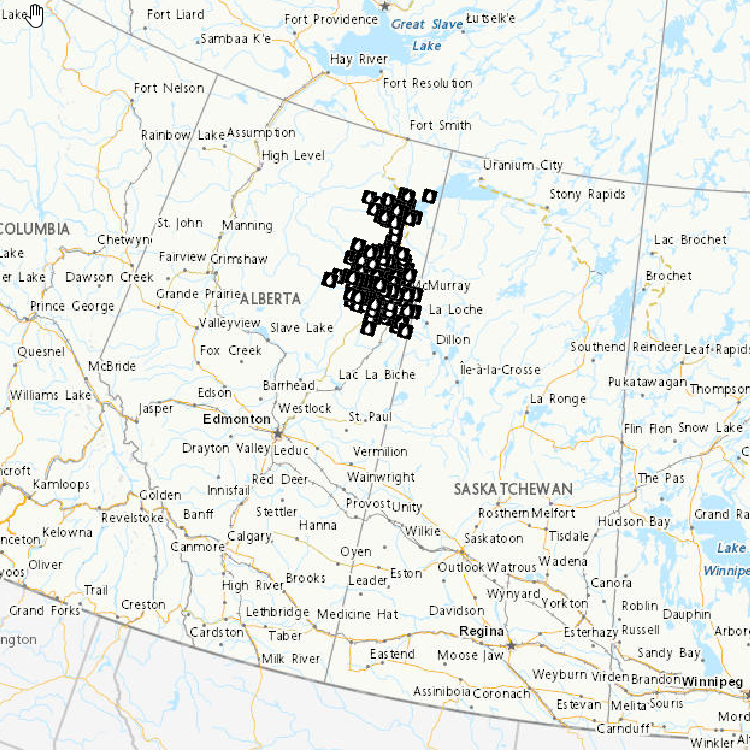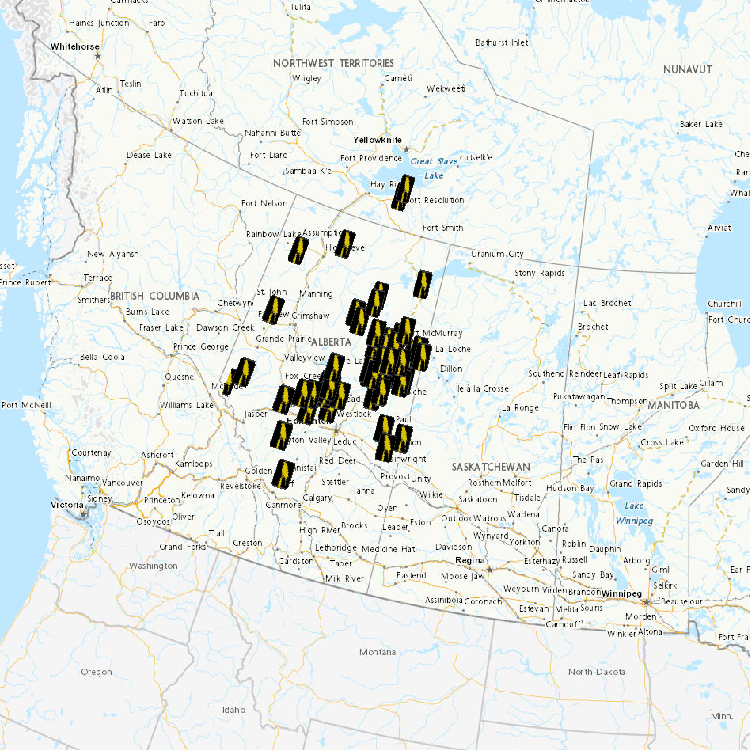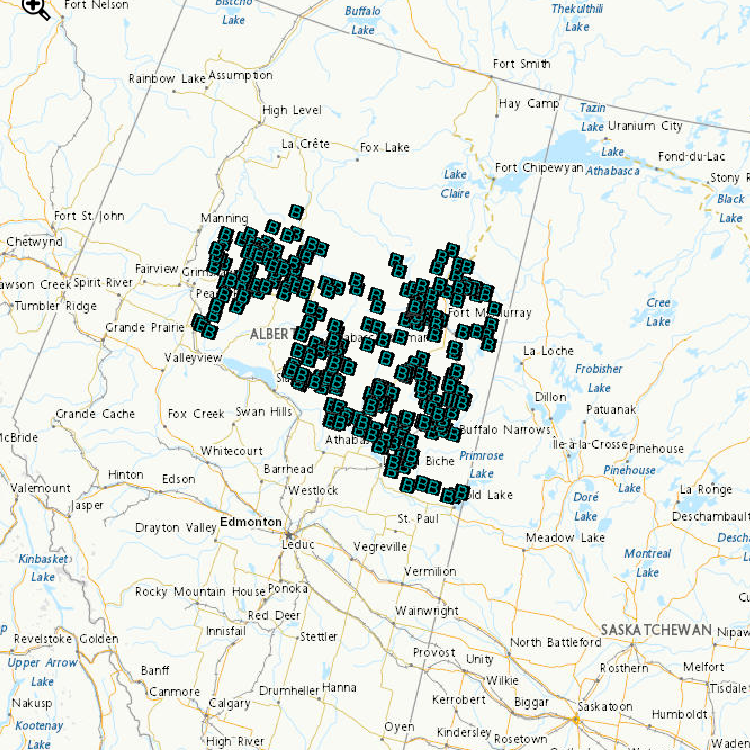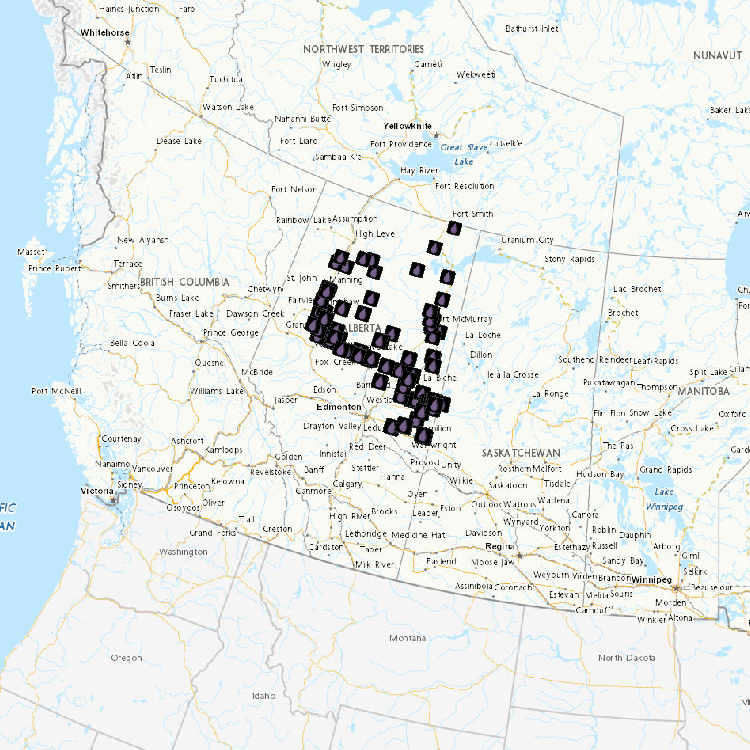Observation/Measurement
Type of resources
Topics
Keywords
Contact for the resource
Provided by
Years
Formats
Representation types
Update frequencies
status
-
Wild fish community data (species, abundance, diversity, length, weight) for 2013 and 2019 are now available for tributaries of the Athabasca River (rivers Steepbank, Ells, Firebag, High Hills, Dunkirk, Horse, Muskeg, Tar and Calumet) and 2017 data for rivers and creeks adjacent to Christina Lake (Christina River, Sunday Creek, Birch Creek, Sawbones Creek, Jackfish Creek and Unnamed Creek). The composition and diversity of the fish communities in these waterbodies have been evaluated over time to identify changes in the presence and abundance of fish species in these waterbodies adjacent to SAGD oil sands mining activity and at sites that are outside of the Athabasca Oil Sands deposit and not influenced by mining activities. Not all waterbodies are adjacent to mining activities and these provide some information as to the natural variability and stability of these fish communities over time. This involved establishing baseline conditions in fish communities in the fall of 2013, 2017 and 2019. This baseline data has assisted in tracking changes in fish communities of these waterbodies over time. Fish community assessments (non-lethal sampling) were carried out in a reach of river using a Smith-Root 12B backpack, Smith-Root LR-24 backpack and or seine at the sites identified in Section 2.3. Length, weight, species identification, and external assessment were performed on fish collected. Fish were then returned to the water at the site of capture. This fish community assessment work commenced September 17th to 27th, 2013, October 3rd to 8th, 2017 and September 24th to October 2nd, 2019. This monitoring activity compliments and supports the Wild Fish Health program.
-
Sediment from Lakes Polycyclic aromatic hydrocarbons (PAHs), 47 elements including numerous metals, and visible reflectance spectroscopy or VRS-chla have been determined in sediment core samples collected in 2012, 2013 and 2014 from 16 small (surface area 4-97 ha; maximum depth ~1-5 m deep), hydrologically simple lakes located 30 to 120 km from major oil sands development areas. Canadian Council of Ministers of the Environment (CCME) guidelines are available for 13 of the 53 PAHs reported here. Sediment concentrations did not exceed Canadian Council of Ministers of the Environment (CCME) probable effects levels (PELs), which define the level above which biological adverse effects are expected to occur, for PAHs in any lake. Exceedances of the CCME interim sediment quality guidelines (ISQG) for the protection of aquatic life occurred for 4 PAHs (naphthalene, 2-methyl naphthalene phenanthrene, and benzo(a)pyrene) in 8 lakes. CCME sediment quality guidelines are available for 7 of the 47 elements reported here. Exceedances of the CCME ISQG for metals were found for arsenic in 3 lakes, cadmium in 8 lakes, mercury in 3 lakes and zinc in 9 lakes. Exceedances of the CCME PELs for metals occurred in 2 lakes for arsenic and 1 lake for zinc. Further assessment of the data is ongoing to examine reasons for exceedances as well as spatial and temporal trends of the PACs and elements. Analyses of lake primary productivity, using visible reflectance spectroscopy or VRS-chla as a proxy, show consistently greater productivity (i.e. VRS-chla concentrations) in the top sediment core slices relative to the bottom, regardless of lake morphological and limnological characteristics and landscape position. Potential drivers of these changes are being examined.
-

Atmospheric Contaminant Deposition using Snowpack The data set includes snow samples (metals, water chemistry and polycyclic aromatic hydrocarbons [PAHs]). Data from 2012-2014 snowpack samples collected from ~90-130 sites located varying distances from the major oil sands development area show deposition patterns and levels consistent with earlier studies carried out in 2008 (Kelly et al. PNAS, 2009 and 2010). As with earlier findings, concentrations of numerous metals, water chemistry parameters (Ni, Pb, Zn, V, La, Al, Fe, total Hg, methyl Hg, total suspended solids [TSS], particulate organic carbon [POC], particulate organic nitrogen [PON], total phosphorus [TP]) and PAHs decrease with distance from the major mining extraction and upgrading facilities. Canadian Council of Ministers of the Environment (CCME) guidelines do not exist for snow.
-
Oil Sands Sediment Exposures of Embryo-larval Fathead Minnows Dataset contains laboratory-studied fathead minnow egg and larval survival rates when exposed to sediments collected from 18 sites in the Athabasca watershed (2010-2014). A controlled laboratory study examined the impacts on fathead minnow eggs and larval development when exposed to collected sediments at concentrations of 1, 5 and/or 25 g/L. Sediments and water were renewed daily, and eggs were assessed as they hatched (in about 5 days), and as the larval fish grew to 8-9 days post hatch (dph), and 15-16 dph. The data in the file present the mean survival (and standard deviation). Two sediment sites caused decreased survival of fathead minnow fry: The Ells River lower site, and the Steepbank River Lower site. These data show that sediment from these sites can affect larval fish survival in the lab. The next steps are to compare these findings to the health data from wild fish collected from these same tributary sites. Toxicity Testing of Groundwater near the Oil Sands Development Dataset contains toxicity studies of groundwaters collected near the Athabasca and Ells rivers. Groundwaters were collected in the summer of 2013 from 4 sites below the riverbeds at depths of 0.5 to 1 metre. Sites were chosen to represent groundwaters close to oil sands tailings ponds and further from tailings ponds and mining activities. Under controlled laboratory conditions, fathead minnow eggs were exposed for 5 days (until hatch) to the groundwaters at standard dilution concentrations of 6, 12, 25, 50, and 100% of the groundwater sample to compare egg and larval fish survival. The data presents the average survival until hatch of 3 repeated exposures (and standard deviation) and 9 repeated exposures for controls. Some groundwater is toxic to minnows and some is not. No correlations were found between toxicity and proximity to a tailings pond. Assessing Toxicity of Oil Sands Related Substances Laboratory fish were exposed to melted snow from sites located close to oil sands mining and upgrading facilities and from sites far away from mining activities to assess the toxicity of substances found in the snow. In addition, river waters, bed sediments, suspended sediments, groundwater and atmospheric depositional samples (pre-melt snow collections) were also tested for toxicity. Fish exposed to undiluted snowmelt showed biological effects. Fish exposed to river water from the region collected during snowmelt conditions showed no effects.
-
Wild fish health data (length, weight, gonad size, etc.) are now available for trout perch collected from the Athabasca and Peace Rivers; white sucker collected from the Athabasca River; longnose sucker collected from the Peace River; slimy sculpin collected from the Steepbank River; lake chub from Alice Creek, the Ells and Dover Rivers; and longnose dace from the Mackay River. Contaminants data available for walleye collected from the Athabasca and Peace Rivers. For each of these data sets, upstream reference areas are provided for comparison to downstream developed sites. Reference data are currently being evaluated for variability between years to develop triggers, and these triggers are essential to eventually quantify potential effects at exposed sites. Using existing critical effect sizes developed in the Environmental Effects Monitoring programs for pulp and paper and metal mining effluents, condition endpoints in white sucker were increased within the deposit. Slimy sculpin condition and reproductive endpoints are also exceeding effect sizes downstream of development sites. This data is now being used to predict future fish health endpoints within sites, between sites and relative to reference variability to help assess change in fish health.
-
Assess the importance of atmospheric deposition of contaminants as a contributor to ecological impacts of oil sands development and identify sources. • Use snowpack measurements sampled across a gridwork to develop maps of winter-time atmospheric contaminant loadings for the region ~100 km from the major upgrading facilities • Assess long-term trends in winter-time atmospheric deposition • Determine the potential impact of wintertime snowpack mercury loads on tributary river water mercury concentrations (Spring Freshet) using Geographic Information System and hydrological modelling approaches • Compare snowpack loadings to those obtained from precipitation monitoring and compare spatial patterns to PAC air measurements obtained from passive sampling network
-

Waterfowl and mammals harvested and trapped at various locations in the oil sands region and in reference locations are assessed for contaminant burdens and toxicology. Wildlife samples are obtained from local hunters and trappers. Tissue samples are analysed for concentrations of oil sands-related contaminants (heavy metals, polycyclic aromatic hydrocarbons, and naphthenic acids). Dead and moribund birds collected from tailing ponds are also evaluated for levels and effects of contaminants.
-

Environment and Climate Change Canada’s cause-effect monitoring is focused on understanding how boreal songbirds, including several Species at Risk, are affected by human activity in the oil sands area, particularly the impact of the physical disturbance of forested habitats from exploration, development and construction of oil sands. Determining the abundance of songbird species associated with various habitat type(s) and understanding how the type and number of birds varies with type and amount of habitat, are important components of assessing the effect of habitat disturbance. Regional-scale monitoring focuses on understanding how and why boreal songbirds, including several Species at Risk, are affected by human activity across the Peace, Athabasca and Cold Lake oil sands area. Local-scale projects focus on addressing gaps in our understanding of complex response patterns at regional scales by targeting specific habitats or development features of interest. These data contribute to: a. improving the design of monitoring programs; b. explaining observed trends in populations (why bird populations are increasing or decreasing); c. predicting population sizes within the oil sands area; and d. assessing the individual, additive and cumulative effects of oil sands and other resource development on boreal birds. Data are used by ECCC and our partners to develop new models and increase the robustness of existing models of bird responses to habitat and disturbance. Because models can be used to predict outcomes of future land management scenarios, these models can assist decision-making by helping evaluate land-use choices before impacts are directly observed.
-

Water level and discharge data are available from Water Survey of Canada’s Hydrometric Network. The Water Survey of Canada (WSC) is the national authority responsible for the collection, interpretation and dissemination of standardized water resource data and information in Canada. In partnership with the provinces, territories and other agencies, WSC operates over 2500 active hydrometric gauges across the country, maintains an archive of historical information for over 7600 stations and provides access to near real-time (water level and stream flow) provisional data at over 1700 locations in Canada.
-
Fish Status and Ecosystem Health - Caged Invertebrates In situ exposures of Hyalella azteca in Athabasca River tributaries - Summary of activities (2010, 2012, 2013, 2014) In situ exposures with Hyalella azteca were conducted within the oil sands region to assess differences in survival and growth of invertebrates caged at natural sites (i.e., exposed to naturally occurring sources of bitumen) compared to sites influenced by oil sands mining activity (i.e., exposed to both naturally occurring and anthropogenic sources of bitumen).Hyalella were collected from a wetland within the Athabasca River watershed but outside the area of oil sands development and activity. They were then placed in cages submerged at 3 sites on the Ells River, 3 sites on the Firebag River, and 4 sites on the Steepbank River. Five cages were deployed per site, each cage containing 20 Hyalella. Cages were removed two weeks after deployment, and Hyalella were counted and weighed as a group to determine growth. The data show no differences in survival or growth of Hyalella caged in situ at any of the 10 sites, when comparing natural sites to sites influenced by oil sands mining activity within each river (i.e., upstream to downstream sites) or between rivers. Caged Mussels Mature mussels (Pyganodon grandis) were collected from a site outside the oil development area (Clearwater River and Long Lake, Alberta) and placed into cages at various sites in the Athabasca River and tributaries for 4 to 6 weeks during the months of August, September and October 2012, 2013 and 2014. The data revealed that mussel growth and survival rates were not affected. Mussels exposed to river water for 4 to 6 weeks were less likely to survive when kept outside of the water for long periods of time (days). Further investigations are warranted to confirm these observations.
